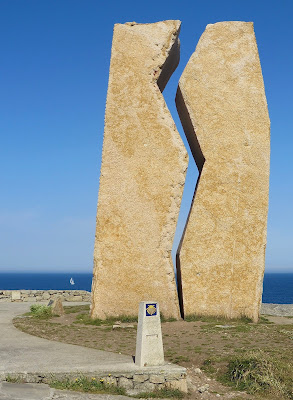Yesterday we spent the day in Muxia before taking the bus back to Santiago. We visited the Sanctuario again and spent time down by the water's edge sitting near the 'healing rock,' called the Pedra dos Cadris (shown above). As we were walking back up the hill, a large sailboat with 3 sails passed by -- there weren't any other boats around, so it stood out against the blue sea.
On the hill above the Sanctuario there's a granite monument called A Ferida, translated as "the wound," by sculptor Alberto Banuelos Fournier. This 36 foot tall structure weighs 400 tons and represents the 'cut' inflicted from an oil spill that happened near Muxia in 2002. 100,000 volunteers from around Spain helped to clean up oil that washed ashore.
In the foreground is the last Camino marker of our "Ex-voto Journey." I put 5 stones on top -- one each for Dad and me and three that represented Mom, Aunt Arlene, and Aunt Ginny.
Below are photos from around Muxia, which is a serene fishing town with a different vibe than Fisterre, a more commercial pilgrim & tourist spot --
While waiting for the bus to Santiago, we stopped at a waterfront cafe and shared a plate of "Padron peppers" with walkers Haiyan, whom we met in Fisterre, and Lindy, a minister from N. Dakota on her second Camino. The peppers are sautéed and served with sea salt -- delicious! Our friends Jose and Jon, who walked the Camino last year, had recommended them to us.
Below are pictures from yesterday and today in Santiago. Included is one at the Pilgrims' Mass, in which we were fortunate enough to see the Botafumiero swing again.
A replica of the Botafumiero at a souvenir shop
The real deal hangs by the altar after the Mass.
A group of young Spanish walkers gather outside the Pilgrim Office where Compostelas are awarded.
In Santiago's Alameda Park stands the sculpture The Two Marias of Santiago de Compostela. Done in 1994, it honors 2 sisters, Maruxa & Coralia Fandino Ricart, who were seamstresses and strolled the park daily dressed in their creations until their passing in the 1980s. The sisters' family had endured hardship after being ostracized for their brothers' resistance activities against Spanish dictator Franco.
Tapas bar at A Taberna do Bispo!
In the early evening we saw musicians in colorful costumes sitting at a cafe near Obradoiro Plaza. A walker from Denmark told us the group performs at the city hall building across from the Cathedral every night during the summer. Later we heard them play to the crowd that had gathered.



























No comments:
Post a Comment